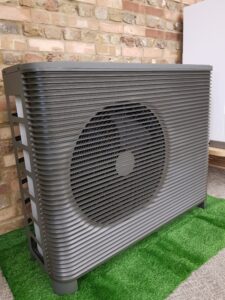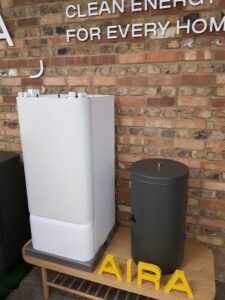
Aira heat pump external fan
I recently attended the launch of a new air source heat pump, by Swedish company Aira. Heat pumps, widely, adopted, would make a significant contribution to reducing carbon emissions from UK homes.
Look around any residential area, and what are the images that come to mind to define progress in reducing carbon emissions? Expensive electric cars parked in drives? Solar panels on roofs? The rare hint of a wind turbine in the distance? The sharp-eyed might spot something else, the very occasional metal box containing a fan attached to the wall of a house.
Be forgiven if you thought this was an air conditioning unit, admittedly a handy feature in our increasingly torrid summers. But it’s more likely the most under-sung, and least expensive, single item we can install at home if we want seriously to reduce the CO2 we produce in our everyday lives, the air source heat pump.
This is the top end of quick-fix carbon-cutting technology in the home. Out goes the gas boiler, for gas is still a fossil fuel however much we are told it is cleaner than oil or coal. In comes a system powered entirely by electricity, and increasingly that electricity is generated from renewables.
Weaning us off gas boilers onto heat pumps will be a huge challenge, but the potential rewards in getting us to net-zero would be enormous too, eliminating the 15% of UK carbon emissions that come from our homes. Until now the excitement has not been shared by the British public, judging by the meagre take up of this alternative. We need the ‘air source heat pump 2.0’, to use the techno-speak, the version of the everyday heating system we can aspire to.
Time to introduce Swedish company Aira, which wants to do exactly that, and create a mass-market for something almost magical, using the free, fresh air outside and a relatively small amount of electricity to heat a home and water. Aira has taken a well-tried product, redesigned it, packaged it slickly and bundled it up with bold assurances, with attractive financing and remote support as part of the deal. It is to deliver 25% heating cost savings and reduce Co2 emissions by at least 75% from the first day. And those savings rise to 100% if the heat pump is powered by green electricity.

Some of Aira’s team at the London launch of the air source heat pump
About 30% of UK greenhouse emissions come from heating, and half of that heating is in the home. Gas heats 87% of UK homes, with gas boilers as the primary source of heat in 22 million UK households. Two million UK boilers are replaced every year, and half of those in a emergency, because they have failed. Most are replaced with a gas boiler, likely to continue to emit Co2 well into the 2030s.
Aira’s product follows standard heat pump principles. An outdoor unit with a fan draws in fresh air. An indoor compression unit creates energy to heat water and distribute it to the home’s taps and showers. Gas is eliminated. It’s no different to other pumps in its promised payback – at least twice, and as high as four times the energy used from drawing that air in, even when it’s really cold outside. It’s the way they done things in frigid Scandinavia for years.
To make the heat pump more attractive to the consumer, Aira’s designers came up with eye-pleasing component, with soft edges, slate grey colour scheme, seductive lines and a timeless feel. Users can control the heat pump settings from anywhere, through an app.
As an established technology, the heat pump is a core feature in any plans to cut greenhouse gas emissions to net-zero by mid-century. The National Audit Committee’s recent report, Decarbonising Home Heating, estimates that a major transition to heat pumps in the UK would, in addition, would also save British families billions of pounds on their heating-related costs and improve energy security. (Half of UK gas is imported.) The Intergovernmental Panel on Climate Change (IPCC) comments: ‘Experts see the policy [heat pumps] as essential to tackle emissions from the UK’s carbon intensive homes.’
Does turning fresh air into cosy home heating still sound too good to be true? So let’s look at the Coefficient of Performance (COP), the standard performance metric for heat pumps. It compares the amount of energy put into a heating system with the amount that it puts out as useful heat, to warm the home. A COP of 1 means that each unit of energy used to run the system returns one are unit of heat – which means 100% efficiency.
Fossil fuel boilers are never 100% efficient because some of the heat is lost with flue gases. So, gas boilers typically operate at around 85% efficiency, equivalent to a COP of 0.85. Heat pumps that use electricity to gather extra heat from the outside air typically generate at least two units of heat for each unit of input. They can have a COP of two or above, meaning they are 200%, 300%, or even more efficient. even on the coldest winter days.

Heat pump compression unit
Daniel Särefjord, Aira UK CEO, who blames the sluggish sales of air pumps in the UK on low customer awareness and artificially low gas prices, underlined the transformative power of air source heating at the company’s launch of its heat pump in the UK in March, (2024). ‘The government needs to go further and faster to unlock the opportunities of heat pumps. We are still falling behind.’
The immediate roadblock to greater take up is cost. Could we even afford them? It’s true that heat pumps cost more than gas boilers. In 2023 the average installation cost of an air source heat pump in the UK was £12,368, compared to £2,500-£3,000 for a gas boiler. But the government is addressing that price differential with a generous £7,500 grant (since 2023) to try to speed the transition, and the removal of VAT on any clean energy improvements to homes until 31st March 2027. Factor that in and the cost is not so much more than the price of a new gas boiler.
I used the cost calculator on the Aira website for a rough estimate of the cost of a putative system in my house. It estimated savings over 20 years with an Aira heat pump of £12,554, compared to a gas boiler. The upfront cost of of the system is the would be £4,490 (with government grant) compared to £3,000 for a new gas boiler. Maintenance over 20 years would come to £9,360 (gas) compared to £300 for the air source heater. Heating costs would be higher too, over 20 years – £14,407 compared to £9,424. So total costs over 20 years: £26,767 for gas against £14,214 for the air source heater, bringing us to that £12,554 saving. And, according to Estate agent Savills, buyers pay a premium for homes with heat pumps. Recent UK research shows that a heat pump could add between 1.7% and 3.0% to the value of an average home.
Air source heat pumps are available from a number of manufacturers, and providers, including energy companies. Aira seems to be going further, redesigning the system to make it a reassuring friend and servant in the home. It self-regulates, constantly optimising its performance. Thermostats measure indoor temperature, sending data to the heat pump so it can learn how the home heats and cools down, adjusting where necessary. And it consults the local weather forecast, adjusting itself based on predicted temperatures.
The system learns the customer’s routine and household habits, from preferred shower times to the home’s thermal properties – how quickly it warms and cools. It can plan precisely, and prepare the right amount of hot water required, rather than over-providing. ‘Away Mode’ saves energy when the home is empty for a time. The temperature is lowered and the hot water paused. Then everything returns to normal when the residents come home.
Särefjord says the pumps should be largely maintenance free. Faults can be registered remotely by the company through the system’s electronic connectivity. ‘We will will see problems before the customer is aware,’ he said. ‘We will be able to tweak remotely without a plumber having to come round.’
Aira, which launched operations in Italy in 2023, plans to operate from four sites in the UK, with 250 employees and two academies. The company is hiring teams of engineers – it eventually wants 8000.The pumps themselves will be made in Poland.
Heat pumps are also a mature technology, tried and tested. Yet in major economies such as the UK and Germany, they are the subject of hostile and misleading reporting across many mainstream media outlets. There are a number of persistent myths, regularly recycled. Carbon Brief (CB), a UK-based website covering the latest developments in climate and energy policy. fact-checked and called out some of the most common.
For example: ‘Heat pumps don’t work in existing buildings.’ But millions of buildings of all ages have been fitted with heat pumps around the world. The UK government’s scheme, which offers grants to households replacing boilers with heat pumps, only funds work in existing homes. More support for the assertion that pumps would work for the majority of UK households came in a recent report from Nesta, an innovation agency focussed on innovation for public benefit. In this, the first major survey of heat pump users, people in older houses with heat pumps, properly installed, were just as likely to be satisfied with their heating as those in newer properties.
Then we have: ‘Heat pumps only work in highly insulated buildings.’ Obviously without insulation heat loss is higher. More heat needs to be generated by the system. And it is easier and cheaper to heat a well insulated home. But heat pumps can work in any building ‘if sized, designed and installed correctly’, notes Carbon Brief. They are approved both for new builds and renovations.
Heat pumps are noisy? ‘Air-source heat pumps generate a certain degree of noise, due to the fan that circulates ambient air around the outdoor unit,’ say Carbon Brief. ‘But they can be very quiet’, and ‘sound emissions from heat pumps were not reported as noticeable’ by the majority of respondents in the study commissioned by the UK government. The noise limit for heat pumps in the UK is 42 decibels. a similar volume to a refrigerator.
What about the carbon emissions resulting from making heat pumps? Surely it won’t cut carbon much if you rip out a perfectly good gas boiler, and replace it with a heat pump. Carbon Brief estimates that replacing a gas boiler with a heat pump would cut emissions by 77-86%, including the embodied emissions from manufacturing the heat pump. The heat pump would offset its embodied carbon after 13 months.
Then, there’s: ‘Could the grid cope with heat pumps?’ (A reference to the additional electricity required as the UK phases out gas.) The transition to heat pumps will take decades, giving operators and energy suppliers ample time to adjust, says CB.
The Climate Change Act 2008 commits the UK by law to reduce greenhouse gas emissions to zero by 2050. 40.6% of the UK energy mix came from renewables in the 12 months to April 2024 — wind 29.7%, biomass 5.2%, solar 4.5% and hydro 1.2%. In the same 12 months, 31.1% of the UK energy mix was from fossil fuels — gas 30.1% and coal 1.0%. Over the past 10 years the percentage of the UK’s energy from fossil fuels has fallen from 58.1% in 2014 to 32.2% in 2023. The percentage of UK energy from renewables has grown in the same time from 10.7% to (April 2024) 40.6%.
Yet gas still heats 87% of UK homes. But where does the gas come from? It was never Russia. Russia’s invasion of Ukraine had a huge effect on gas prices world-wide, and the UK’s energy prices shot up as a result. But although 35% of all natural gas provided to the European continent came from Russia, the UK did not rely on Russian gas. Only 3% of the UK’s supply came from the Russian Federation, in the form of liquefied natural gas (LNG).
The international market supplies close to 50% of UK gas. Norway is the UK’s largest international gas supplier, accounting for 77% of the total UK gas imports. The UK also imports LNG from Qatar – 39% of it in 2021. The balance of our LNG imports comes from the USA, Denmark and Belgium. 50% of the gas we consume comes from domestic production and reserves from the United Kingdom’s North Sea basin.
An outright ban on boilers in the UK is not feasible. However the 2025 gas boiler ban for new build homes is. Beyond that the target is to end the sale of new gas boilers in 2035, forcing homeowners to transition over to a more efficient heating system rather than simply replacing an old gas boiler. But this date probably needs fresh political commitment.
